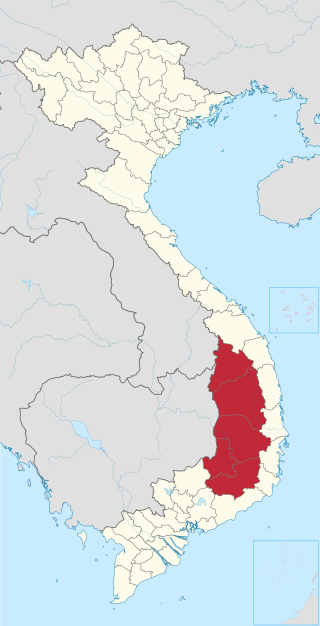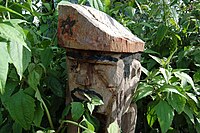
Demographic features of the population of Cambodia include population density, ethnicity, education level, health of the populace, economic status, religious affiliations and other aspects of the population.

The Chams, or Champa people, are an Austronesian ethnic group in Southeast Asia and are the original inhabitants of central Vietnam and coastal Cambodia before the arrival of the Cambodians and Vietnamese, during the expansion of the Khmer Empire and the Vietnamese conquest of Champa.

Champa was a collection of independent Cham polities that extended across the coast of what is present-day central and southern Vietnam from approximately the 2nd century CE until 1832. According to earliest historical references found in ancient sources, the first Cham polities were established around the 2nd to 3rd centuries CE, in the wake of Khu Liên's rebellion against the rule of China's Eastern Han dynasty, and lasted until when the final remaining principality of Champa was annexed by Emperor Minh Mạng of the Vietnamese Nguyễn dynasty as part of the expansionist Nam tiến policy. The kingdom was known variously as Nagaracampa, Champa (ꨌꩌꨛꨩ) in modern Cham, and Châmpa (ចាម្ប៉ា) in the Khmer inscriptions, Chiêm Thành in Vietnamese, Campa in Malay, Zhànchéng in Chinese records, and al-Ṣanf in Middle Eastern Muslim records.

Montagnards is an umbrella term for the various indigenous peoples of the Central Highlands of Vietnam. The French term Montagnard ( ) signifies a mountain dweller, and is a carryover from the French colonial period in Vietnam. In Vietnamese, they are known by the term người Thượng, although this term can also be applied to other minority ethnic groups in Vietnam. In modern Vietnam, both terms are archaic, and indigenous ethnic groups are referred to as đồng bào or người dân tộc thiểu số. Earlier they were referred to pejoratively as the mọi. Sometimes the term Degar is used for the group as well. Most of those living in the United States refer to themselves as Montagnards, while those living in Vietnam refer to themselves by their individual ethnic group.

Ratanakiri is a province of northeast Cambodia. It borders the provinces of Mondulkiri to the south and Stung Treng to the west and the countries of Laos (Attapeu) and Vietnam to the north and east, respectively. The province extends from the mountains of the Annamite Range in the north, across a hilly plateau between the Tonlé San and Tonlé Srepok rivers, to tropical deciduous forests in the south. In recent years, logging and mining have scarred Ratanakiri's environment, long known for its beauty.

The Central Highlands, South Central Highlands, Western Highlands or Midland Highlands is a region located in the south central part of Vietnam. It contains the provinces of Đắk Lắk, Đắk Nông, Gia Lai, Kon Tum, and Lâm Đồng.

The largest of the ethnic groups in Cambodia are the Khmer, who comprise 95.8% of the total population and primarily inhabit the lowland Mekong subregion and the central plains. The Khmer historically have lived near the lower Mekong River in a contiguous arc that runs from the southern Khorat Plateau where modern-day Thailand, Laos and Cambodia meet in the northeast, stretching southwest through the lands surrounding Tonle Sap lake to the Cardamom Mountains, then continues back southeast to the mouth of the Mekong River in southeastern Vietnam.
Jarai is a Malayo-Polynesian language spoken by the Jarai people of Vietnam and Cambodia. The speakers of Jarai number approximately 530,000, not including other possible Jarai communities in countries other than Vietnam and Cambodia such as United States of America. They are the largest of the upland ethnic groups of Vietnam's Central Highlands known as Degar or Montagnards, and 25 per cent of the population in the Cambodian province of Ratanakiri.

The Bahnar or Ba-Na (Vietnamese pronunciation:[ɓaː˧naː˧] are an ethnic group of Vietnam and the indigenous people of the Central Highland provinces of Gia Lai and Kon Tum, as well as the coastal provinces of Bình Định and Phú Yên. They speak the Bahnar language, a language in the Bahnaric language group that belongs to the Mon-Khmer language family.

The Chamic languages, also known as Aceh–Chamic and Acehnese–Chamic, are a group of ten languages spoken in Aceh and in parts of Cambodia, Thailand, Vietnam and Hainan, China. The Chamic languages are a subgroup of Malayo-Polynesian languages in the Austronesian family. The ancestor of this subfamily, proto-Chamic, is associated with the Sa Huỳnh culture, its speakers arriving in what is now Vietnam from Formosa.

The Rhade or Êđê are an indigenous Austronesian ethnic group of southern Vietnam.

The Raglai people are a Chamic ethnic group mainly living in Khánh Hòa and Ninh Thuận provinces of Central Vietnam. They speak Roglai - a Malayo-Polynesian language. The word Raglai means Forest in their language. The Raglai's population was 146,613 in 2019.

The Churu people are a Chams related ethnic group living mainly in Lâm Đồng, and Bình Thuận provinces of Central Vietnam. They speak Chru, a Malayo-Polynesian language. The word Churu means Land Expander in their language. The Churu's population was 23,242 in 2019.

The United Front for the Liberation of Oppressed Races was an organization whose objective was autonomy for various indigenous peoples and ethnic minorities in South Vietnam, including the Montagnards in the Central Highlands, the Chams in Central Vietnam, and the Khmer Krom in Southern Vietnam. Initially a political movement, after 1969 it evolved into a fragmented guerrilla group that carried on simultaneous insurgencies against the governments of South Vietnam under President Nguyen Van Thieu and North Vietnam of Ho Chi Minh. Opposed to all forms of Vietnamese rule, FULRO fought against both sides in the Vietnam War against the Soviet-aligned North and the American-aligned South at the same time. FULRO's primary supporter during the 1960s and early 1970s conflict in Southeast Asia was Cambodia, with some aid sent by the People's Republic of China during the period of the Third Indochina War.

Nam tiến is a historiographical concept that describes the historic southward expansion of the territory of Vietnamese dynasties' dominions and ethnic Kinh people from the 11th to the 19th centuries. The concept of Nam tiến has differing interpretations, with some equating it to Viet colonialism of the south and to a series of wars and conflicts between several Vietnamese dynasties and Champa Kingdoms, which resulted in the annexation and Vietnamization of the former Cham states as well as indigenous territories. The nam tiến became one of the dominant themes of the narrative that Vietnamese nationalists created in the 20th century, alongside an emphasis on non-Chinese origin and Vietnamese homogeneity. Within Vietnamese nationalism and Greater Vietnam ideology, it served as a romanticized conceptualization of the Vietnamese identity, especially in South Vietnam and modern Vietnam.

The Khmer Loeu is the collective name given to the various indigenous ethnic groups residing in the highlands of Cambodia. The Khmer Loeu are found mainly in the northeastern provinces of Ratanakiri, Stung Treng, and Mondulkiri. Most of the highland groups are Mon-Khmer peoples and are distantly related, to one degree or another, to the Khmer. Two of the Khmer Loeu groups are Chamic peoples, a branch of the Austronesian peoples, and have a very different linguistic and cultural background. The Mon–Khmer-speaking tribes are the aboriginal inhabitants of mainland Southeast Asia, their ancestors having trickled into the area from the northwest during the prehistoric metal ages. The Austronesian-speaking groups, Rade and Jarai, are descendants of the Malayo-Polynesian peoples who came to what is now coastal Vietnam; they established the Champa kingdoms, and after their decline migrated west over the Annamite Range, dispersing between the Mon–Khmer groups.
The United Front for the Liberation of Oppressed Races waged a nearly three decade long insurgency against the governments of North and South Vietnam, and later the unified Socialist Republic of Vietnam. The FULRO insurgents represented the interests of indigenous Muslim and Hindu Cham, Montagnards, and Buddhist Khmer Krom against the ethnic Kinh Vietnamese. They were supported and equipped by China and Cambodia according to those countries' interests in the Indochina Wars.

BAJARAKA is a separatist movement that protested the discriminatory policies of the Montagnards in the Central Highlands under the Republic of Vietnam government. It was the predecessor of the United Front for the Liberation of Oppressed Races (FULRO) organization.

The native inhabitants of the Central Highlands of Vietnam are known as the Montagnard. The Vietnamese conquered the Central Highlands during their "march to the south". Ethnic Vietnamese (Kinh) people now outnumber the indigenous Degars after state-sponsored colonization directed by both the government of South Vietnam and the current Communist government of unified Vietnam. The Montagnards have engaged in conflicts with the Vietnamese, from the anti-Communist South Vietnamese government, the Viet Cong, to the Communist government of unified Vietnam. There are contrasting views on this issue, as the constitution of the government of Vietnam states "Article 36 of the Constitution, the state invests heavily in education and supports various preferential programmes for ethnic minorities, like ethnic minority boarding schools, lower entry requirements and quota for minorities." Both the initial 1945 constitution and the revised 1992 constitution of North Vietnam and the successor state the Socialist Republic of Vietnam stated that all minority groups in Vietnam have the right to maintain their mother tongues in their schooling as well as to use their languages to preserve their ethnic cultures and values, although the degree of enforcement remains ongoingly debated due to complicated nature.
Vietnamization or Vietnamisation is the acquisition or imposition of elements of Vietnamese culture, in particular the Vietnamese language and customs. This was experienced in some historic periods by the non-Vietnamese populations of territories controlled or substantially under the influence of Vietnam. As with other examples of cultural assimilation, it is partly voluntary and partly forced and most visible in territories where the Vietnamese language or culture had been dominant or their adoption would result in increased prestige or social status, as was the case of nobility in Champa and other minorities like Tai, Chinese, and Khmers. Vietnamization was by and large practised by various administrations.





























